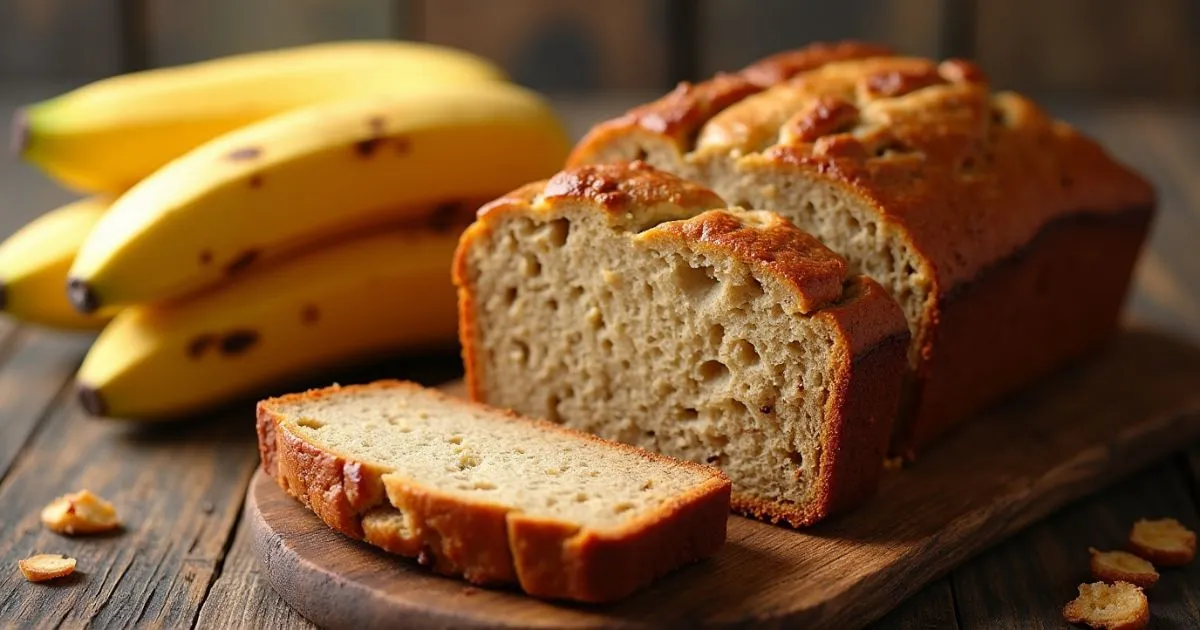Introduction: A Slice of Comfort, Perfect Every Time
Imagine pulling a warm, fragrant loaf of banana bread from the oven—the golden crust giving way to a perfectly moist and tender center. It’s not just a treat; it’s a nostalgic experience. Whether you’re a first-time baker or a seasoned pro, achieving the perfect banana bread texture can be a challenge. Too dense? It feels heavy. Too dry? It’s disappointing. But when done right, banana bread offers a delightful balance of moistness and fluffiness that’s hard to resist. In this guide, we’ll show you how to bake banana bread with the perfect texture every single time.
Table of Contents
Why Texture Matters in Banana Bread


When it comes to banana bread, texture is everything. It’s not just about flavor; the right texture transforms an ordinary loaf into an unforgettable one. Here’s why:
1. Enhances Flavor
A moist, fluffy loaf carries the sweet banana flavor better, while a dense or dry loaf dulls the experience.
2. Improves Eating Experience
The perfect texture ensures each bite melts in your mouth without being overly heavy or sticky.
Common Mistakes to Avoid
To achieve the perfect texture, avoid these common mistakes:
- Overbaking: This leads to dryness.
- Overmixing: This causes dense, chewy bread.
- Wrong Bananas: Using under-ripe bananas can result in a lack of flavor or moisture.
Top Tips for Perfect Bread Texture
1. Use the Right Bananas
The bananas you use make all the difference.
- Go for Overripe Bananas: The more spots, the better! Overripe bananas are naturally sweeter and softer, making them easier to mash and incorporate into the batter.
- Speed Up Ripening: If your bananas aren’t ready, place them in a brown paper bag or microwave them for 30 seconds to soften quickly.
- Pro Tip: Avoid green or barely yellow bananas; they lack the necessary sweetness and moisture.
2. Measure Ingredients Accurately
Precision is key when baking. Even slight mismeasurements can alter the texture.
- Dry Ingredients: Spoon flour into your measuring cup, then level it off with a knife to avoid overpacking.
- Wet Ingredients: Use a liquid measuring cup for ingredients like milk and oil.
Key Insight: Too much flour leads to a dense loaf, while too little results in a soggy, underbaked center.
3. Don’t Overmix the Batter
Overmixing is one of the most common mistakes in banana bread recipes.
- What Happens When You Overmix: Mixing activates gluten in the flour, resulting in a tough, dense loaf.
- What to Do Instead: Gently fold the wet and dry ingredients together until just combined. The batter should still look slightly lumpy.
Visual Tip: If your batter is smooth, you’ve mixed it too much!
4. Add a Moisture Boost
Want irresistibly moist banana bread? Add ingredients that enhance moisture.
- Common Moisture Enhancers: Sour cream, yogurt, or buttermilk.
- Banana Ratio: Ensure bananas make up at least 1/3 of your batter to keep the bread naturally moist without being overly dense.
Ingredient Table:
| Ingredient | Amount | Purpose |
|---|---|---|
| Ripe Bananas | 3 large | Natural sweetness & moisture |
| Sour Cream/Yogurt | 1/2 cup | Adds creaminess & moistness |
| Butter (melted) | 1/2 cup | Ensures rich texture |
5. Bake at the Right Temperature
The baking temperature significantly impacts the texture.
- Ideal Temperature: Bake at 325°F (165°C) for even cooking.
- Avoid Oven Peeking: Opening the oven door too soon can cause the center to sink.
- Toothpick Test: Insert a toothpick into the center. If it comes out with a few crumbs but no wet batter, it’s ready.
Pro Tip: Use an oven thermometer to ensure your oven’s temperature is accurate.
6. Optional Add-Ins for Textural Variety
Adding mix-ins can elevate your banana bread’s texture and flavor.
- For Crunch: Chopped walnuts, pecans, or almonds.
- For Softness: Chocolate chips, dried fruits, or shredded coconut.
Tip: Gently fold these ingredients into the batter to maintain the perfect texture.
Common Texture Problems and Solutions
1. Bread is Too Dry
Causes: Overbaking, too much flour, or insufficient bananas. Fix: Reduce baking time by 5-10 minutes or increase the ratio of bananas or sour cream.
2. Bread is Too Dense
Causes: Overmixing or expired baking powder/soda. Fix: Mix just until combined and ensure your leavening agents are fresh.
3. Soggy Middle
Causes: Undercooking or too many wet ingredients. Fix: Extend baking time or adjust the ratio of wet to dry ingredients.
FAQ Section
How do I store banana bread to maintain texture?
Wrap the loaf in plastic wrap or foil to retain moisture. Store at room temperature for up to 3 days or refrigerate for longer freshness.
Can I make banana bread without eggs?
Yes! Replace eggs with mashed bananas, unsweetened applesauce, or a flax egg (1 tablespoon ground flaxseed + 2.5 tablespoons water).
What makes banana bread moist?
The combination of ripe bananas, fats (like butter or oil), and dairy (such as sour cream or yogurt) ensures a moist loaf.
Why is my banana bread gummy?
Overmixing the batter or underbaking are common culprits.
Can I freeze banana bread?
Absolutely! Wrap tightly in plastic wrap, then foil, and freeze for up to 3 months. Thaw at room temperature before serving.
Conclusion: Your Best Banana Bread Awaits
Achieving the perfect banana bread texture is all about balance. By choosing the right bananas, measuring accurately, and following these tips, you’ll create a loaf that’s irresistibly moist, tender, and flavorful. Whether you’re baking for a special occasion or simply indulging in a homemade treat, these strategies will ensure success every time. Now, it’s your turn—grab those ripe bananas and start baking your best banana bread yet!


1 thought on “Banana Bread: 7 Top Tips for the Perfect Texture”
Comments are closed.